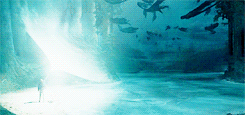
«This ancient and mysterious charm conjures a magical guardian, a projection of all your most positive feelings. The Patronus Charm is difficult, and many witches and wizards are unable to produce a full, corporeal Patronus, a guardian which generally takes the shape of the animal with whom they share the deepest affinity. You may suspect, but you will never truly know what form your Patronus will take until you succeed in conjuring it.«—Miranda Goshawk‘s overview of the Patronus Charm
The Patronus Charm (Expecto Patronum) is the most famous and one of the most powerful defensive charms known to wizardkind. It is an immensely complicated and an extremely difficult spell, that evokes a partially-tangible positive energy force known as a Patronus (pl. Patronuses) or spirit guardian. It is the primary protection against Dementors and Lethifolds, against which there are no other defence.
There are two types of Patronuses: corporeal which means a Patronus with a particular shape and form and incorporeal Patronus. Incorporeal Patronuses have no particular shape and do not protect against dementors the way corporeal Patronuses do. However, some wizards like Remus Lupin choose to cast incorporeal Patronuses to hide their identity.
Nature
The Patronus represents that which is hidden, unknown but necessary within the personality. When a human confronted with inhuman evil, such as the Dementor, they must draw upon resources he or she may never have needed, and the Patronus is the awakened secret self that lies dormant until needed, but which must now be brought to light. Patronuses take forms that their casters might not expect, for which they have never felt a particular affinity, or (in rare cases) even recognise. Every Patronus is as unique as its creator and even identical twins have been known to produce very different Patronuses.[
The unusual witches and wizards who produce a Patronus that takes the form of their favourite animal is an indicator of obsession or eccentricity. Here is a wizard who may not be able to hide their essential self in common life, who may, indeed, parade tendencies that others might prefer to conceal. Whatever the form of their Patronus, you would be well-advised to show respect, and occasionally caution, towards a witch or wizard who produces the Patronus of their choice.
Casting
The vast majority of witches and wizards are unable to produce any form of Patronus, and to create even an intangible one is generally considered a mark of superior magical ability. Rubeus Hagrid is an example of a wizard that cannot conjure any form of Patronus, as the charm is too difficult for him.[
Given their long affinity with humans it is perhaps unsurprising that among the most common Patronuses when cast (although it must be remembered that any corporeal Patronus is highly unusual) are dogs, cats, and horses.
To successfully cast the spell, one begins by mustering the happiest memory they can think of (the happier the memory, the better the charm will work). Alternatively, one could imagine a scenario that would make for a very happy memory, as Harry did for his D.A.D.A. O.W.L. The next step is to begin drawing circles with their wand so as to increase the power of their spell. They must then say the incantation, Expecto Patronum; the Patronus will come from the tip of the wand and can be directed towards a target by pointing one’s wand at said target. It is possible to disguise the form one’s Patronus takes, which was done both by Severus Snape to hide his love for Lily Evans, and by Remus Lupin, who felt it would give away his condition.[
Also some witches and wizards may be unable to produce a Patronus at all until they have undergone some kind of psychic shock.
The Patronus
A successfully conjured Patronus can take two forms: incorporeal and corporeal, and both types vary greatly in their appearances and strength.
Incorporeal
«A thin wisp of silver escaped his wand and hovered like mist before him. «—Description of an incorporeal shield Patronus

An incorporeal[ Patronus is one which does not resemble any living creature and has few distinguishing features (if any). Incorporeal Patronuses resemble a burst of vapour or smoke without any clearly defined form shooting from the tip of the wand. While they may be partially effective at halting dementors (but not repelling them) and shielding the caster from them, incorporeal Patronuses are not «fully-fledged» Patronuses, and are regarded as a more primitive or weaker version of the true Charm.
Corporeal
Harry Potter: «What does a Patronus look like?«Remus Lupin: «Each one is unique to the wizard who conjures it.«— Discussion of corporeal forms a Patronus can take.
A corporeal Patronus is one that is fully-formed, taking the shape of bright-white, translucent animal. The specific animal forms that corporeal Patronuses take vary from person to person and reflect each individual’s innermost personality.
Patronus forms, however, are subject to change if the caster goes through an emotional upheaval of some sort, including falling in eternal, unchanging love. For example, Nymphadora Tonks‘s Patronus changed from its previous form to that of a four-legged creature which others guessed was a wolf because then it would reflect her love of Remus Lupin, himself a werewolf.[ Another example is Severus Snape, whose Patronus was that of a doe, the same as Lily Evans, though this may have been the case all along rather than a change from its original form, as Snape was in love with Lily for most of his life.
Based on the fact that Patronuses are conjured by recalling happy memories, it stands to reason that a Patronus might change its form after one falls in love and the memories used to conjure the Patronus largely revolve around the person the caster is in love with. In addition, it seems that some couples have «complementary» Patronuses (male and female forms of the same animal), such as Lily and James Potter. It is, however, unknown if this is a coincidence or not. If a wizard is an Animagus and can summon a corporeal Patronus, the two may take the same form, as was the case for Minerva McGonagall and James Potter.[ Remus Lupin’s Patronus takes the form of a wolf, rather than a werewolf; whether or not all werewolves would generate a similar Patronus is unknown. It stands to reason that it’s likely due to Remus’ best memories of his youth revolving around the acceptance he felt despite his condition, in which he felt more at home in his wolf form during those times, rather than cursed by it. Also, due to his nature as desiring a sense of belonging at his core, much like a true wolf.
Most Patronuses take the form of an ordinary animal. Magical creatures, such as Albus Dumbledore‘s phoenix Patronus, are uncommon. It is extremely rare for Patronuses to take the form of extinct animals. Hedley Fleetwood‘s woolly mammoth Patronus is a notable exception.[ Andros the Invincible was the only wizard capable of casting a Patronus the size of a Giant, although whether it was a giant or not is unknown.
The corporeal Patronus is also better at repelling Dementors than the non-corporeal form.